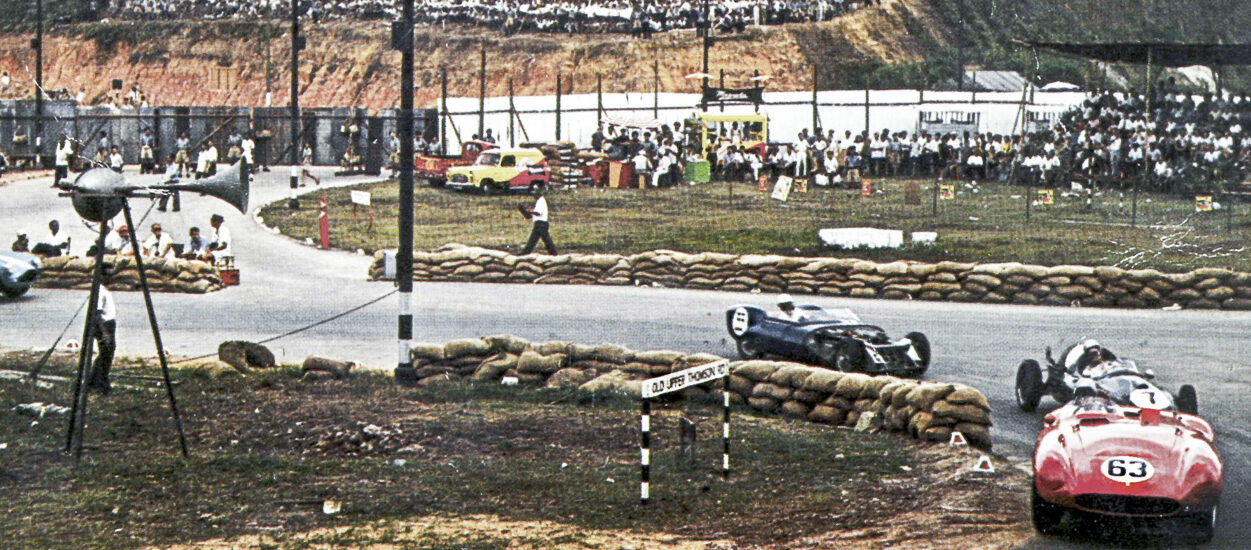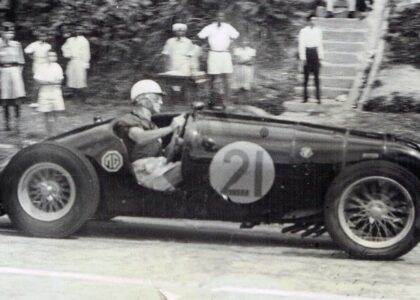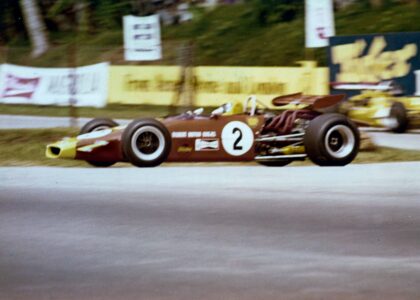Words by Eli Solomon
Postcard collecting must be a big thing in Singapore because there are a number of books on the subject. I’ve never been interested in postcards, sticking to original negatives, slides, film and other ephemera related to motor sports. Once in a way, a postcard shows up at auction that catches my attention. VIEWFINDER is Rewind Media’s new online series based on photos in the Rewind Media Archives. This is Edition #1 – Sembawang Hill Circus.
Several years ago I acquired an interesting postcard in Sydney while on a trip to participate at the historic Tasman Revival race meeting. The colour photo depicted a scene from the 1961 Singapore Grand Prix. This was the inaugural Grand Prix of a 13-year series that stretched till 1973. It showed cars negotiating the old Sembawang Hill Circus.
VIEWFINDER No.1
Recently I acquired a second similar postcard, franked with a 1962 Singapore postage stamp depicting the harlequin Rasbora Heteromorpha fish. The card was sent to an address in the UK in 1962.
Photo aside (it has been captioned in the following online articles: 60 YEARS AGO: THE ORIENT YEAR GRAND PRIX; FOR THE PRICE OF A HOUSE – ASTON MARTIN DB3S/106; JUST THE RIGHT AMOUNT OF TORQUE), the caption on ‘divided back’ style Chrome postcard on the reverse side read:
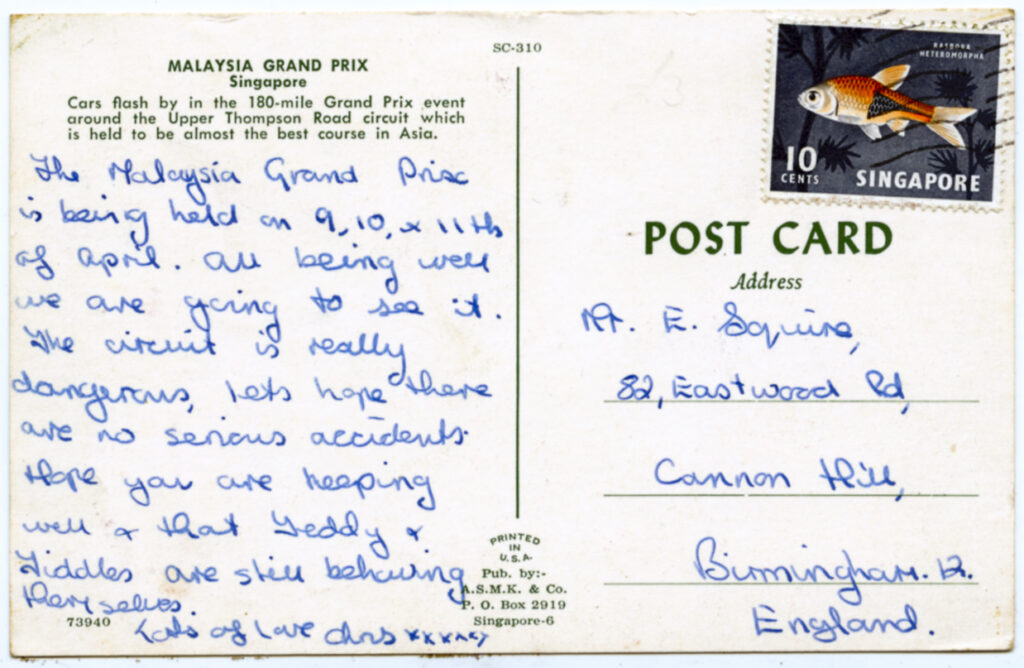
The postcard with the 1962 stamp.
MALAYSIA GRAND PRIX
Singapore
Cars flash by in the 180-mile Grand Prix event around the Upper Thompson Road circuit which is held to be almost the best course in Asia.
Printed in U.S.A.
Pub. by:- A.S.M.K. & Co.
P.O. Box 2919
Singapore-6
The contents of the card revealed that the sender intended to attend the event in April 19621 but there were a couple of things in the caption that stood out.
Firstly, the 1961 Grand Prix was officially called the Singapore Grand Prix. The organisers, Singapore’s Ministry of Culture, piggybacked the Orient Year celebrations.
Interestingly, during the same month, Singapore’s then Prime Minister delivered a series of radio talks to campaign for a merger with Malaysia (in 1961 Singapore was still a Crown Colony under Britain, merger into the Federation of Malaysia only taking place in 1963).
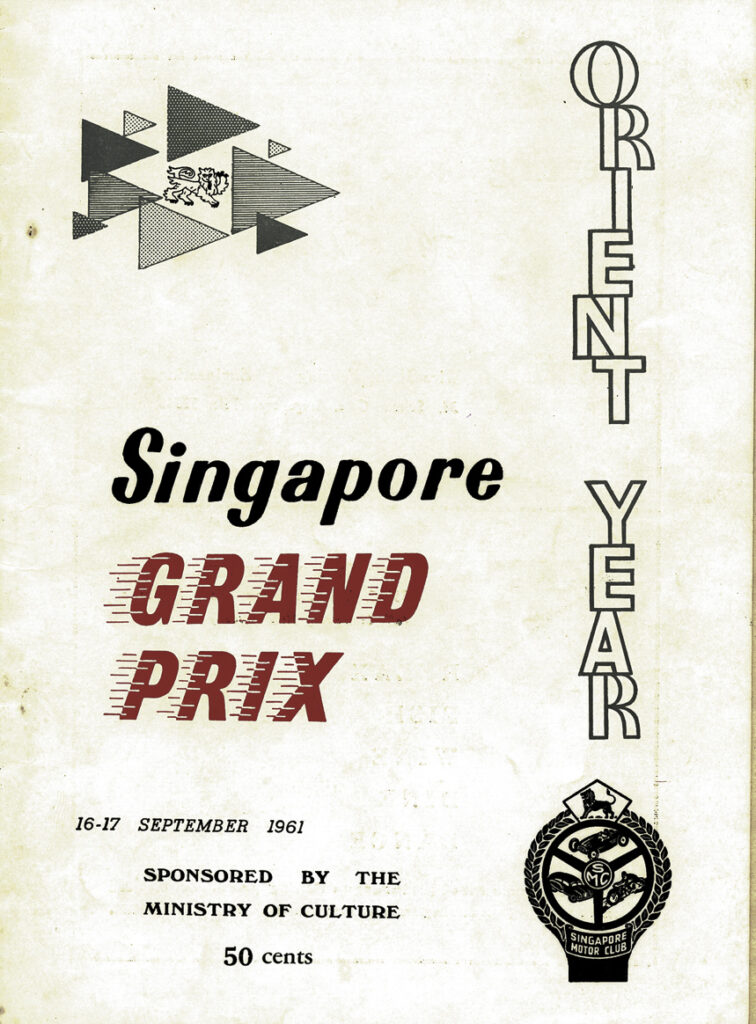
This is the cover of the official program cover for the 1961 Singapore Grand Prix. The event was held in September that year, the only occasion it was not hosted over the Easter weekend (1962-1973).
Secondly, the roads on which the Grand Prix took place was New and Old Upper Thomson Road, not spelt Thompson but Thomson, after John Turnbull Thomson2, Government Surveyor in Singapore in 1844 and later on, Superintendent of Roads and Public Works. So if someone tells you the track was at Thompson Road, ask it if they are referring to Thompson Speedway in Thompson, Connecticut. Or perhaps they may be attempting to rewrite history.
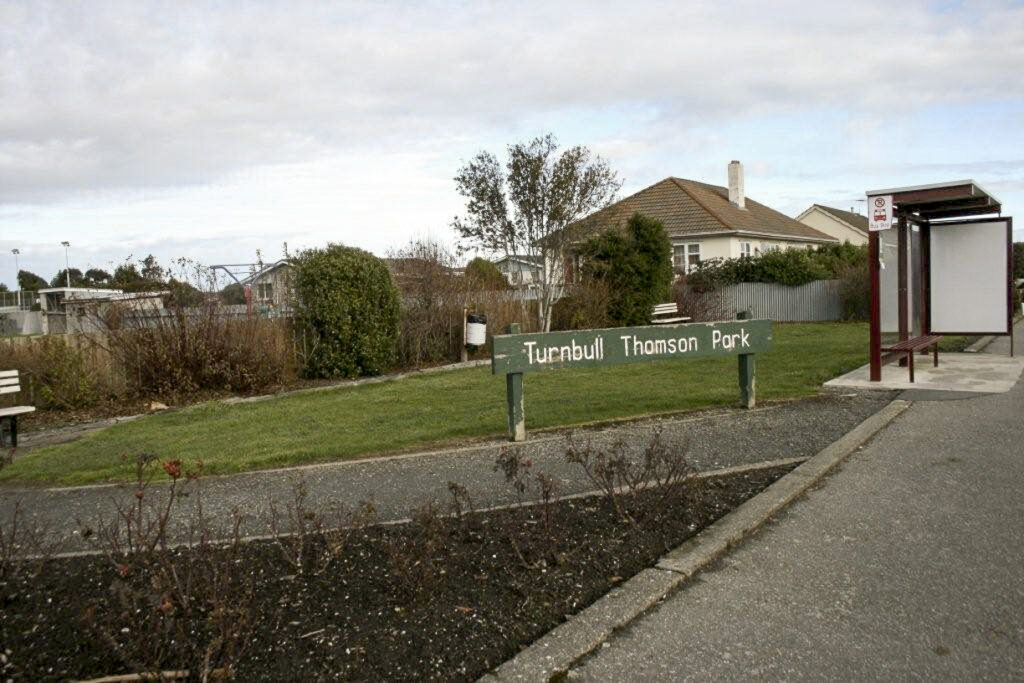
A park named in honour of John Turnbull Thomson in Invercargill.
THE PHOTO
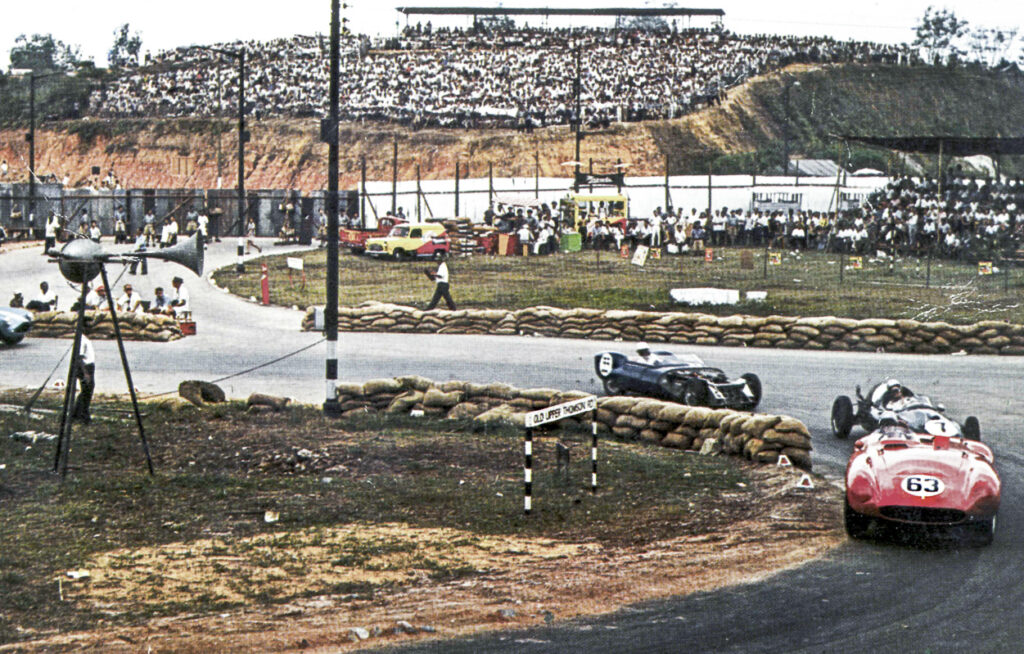
The postcard in question. Four cars are featured negotiating the exit of New Upper Thomson Road and the entry into Old Upper Thomson Road. Sembawang Circus is to the right. Three of these cars have been written about in this online blog – the Ferrari Monza/Mondial, The T51 FPF Cooper Climax and the Aston Martin DB3S. The Lotus Eleven (sans front bodywork) featured in an early printed edition of Rewind Magazine.
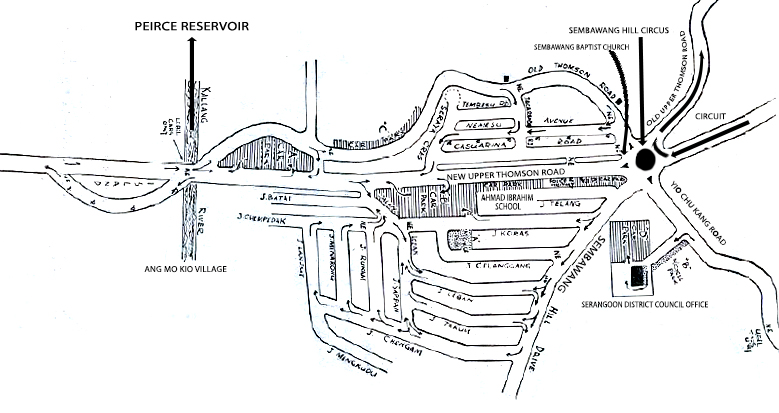
Upper Thomson Road and its environs, showing the circus, school, church, reservoir and entrance to the circus. The local experts will be able to add much more detail to this map.
The background scene of this Kodachrome layered offset litho postcard was the hill where the Serangoon District Office (which was launched in September 1958) stood. You’d only go there to get your dog licensed and do various other sundry things, like vote etc.
East of the hill was undeveloped ground that would eventually become Thomson Hills Estate in 19733. Across Yio Chu Kang Road (left of the photo) was the entrance into the valley and Teachers’ Housing Estate (only launched in 1967). But this was 1961 and much of the area was still farmland (fish farms, pig farms etc) and kampongs.
SEMBAWANG HILLS
There was the district office, a new estate (Sembawang Hill Estate4), a new road (New Upper Thomson Road, built in 1958), the roundabout (Sembawang Hill Circus branched to Yio Chu Kang Road, New Upper Thomson Road, Old Upper Thomson Road (leading to Peirce Reservoir5 and Sembawang Hill Drive), which was probably constructed following the creation of New Upper Thomson Road through plantation land6 alongside Ahmad Ibrahim Integrated Secondary School (referred to as Ahmad Ibrahim English School) at the 7-mile stone Upper Thomson Road (the school was completed in late 1962 and opened in May 1963) while officials and press car parks were situated at the District office. One of the grandstands was also situated on the hill adjacent to the District office, overlooking Sembawang Circus (where the Grand Prix emergency evacuation helipad was situated in the early 1970s).
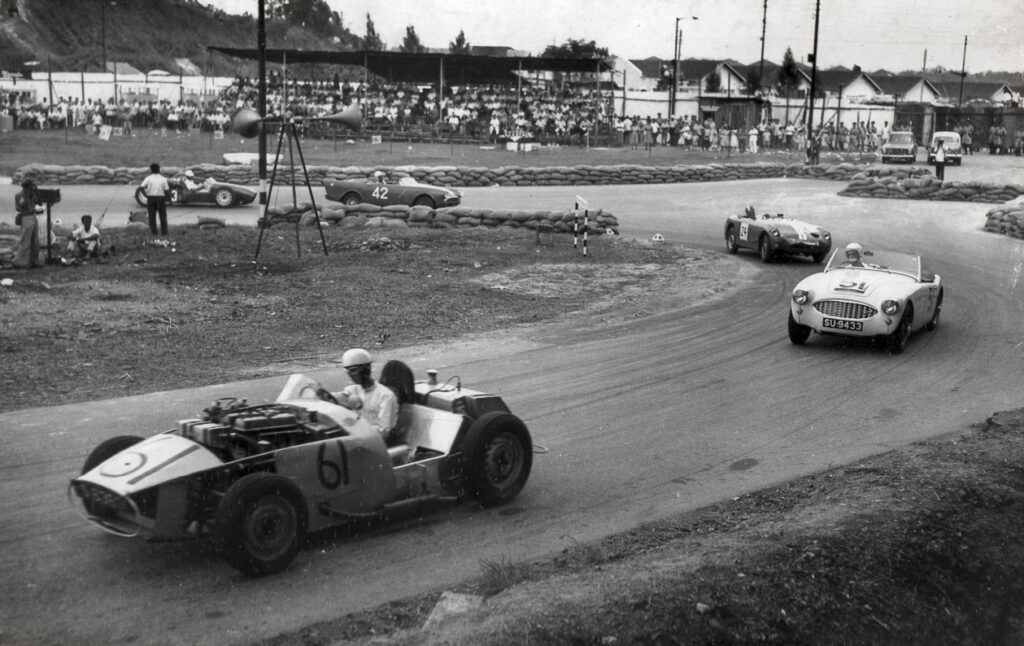
A scene from the inaugural Singapore Grand Prix. #61 is Chew Chek Leun in his 2.5-litre Riley Special; #51 is Bruce MacRae Smith in his Austin Healey 2955cc; #24 is Eric Cooper in his Sprite; #42 is Sunny Ang in his 1,592cc Sunbeam Alpine; #3 is Chia Eng Quee in his 1,975cc EQ Special. Sembawang Hills Estates is in the background to the right with the VIP enclosure in the middle.
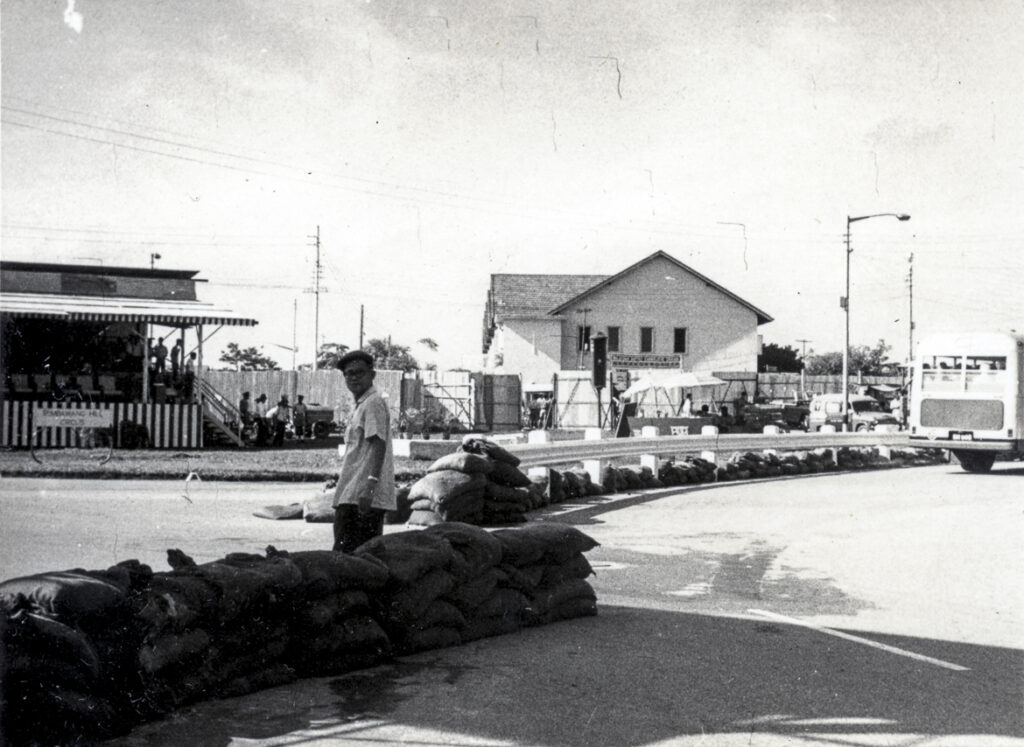
The Sembawang Baptist Church as it was over Easter in 1965. The VIP enclosure is to the left of the photo.
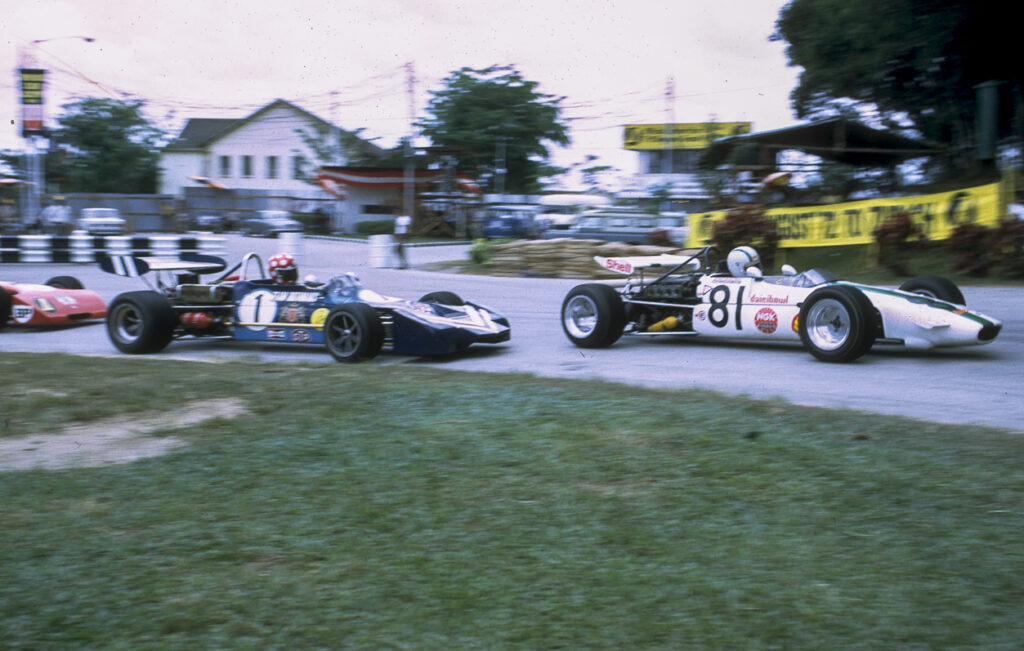
The Singapore Grand Prix in the early 1970s as the cars exit Sembawang Circus and head into Old Upper Thomson Road and The Snakes. In the background is Casuarina Road and Baptist Church (with an additional window visible). The #81 car is Riki Ohkubo’s Brabham BT16 while Sonny Rajah takes the inside line in his Team Rothmans #1 March 712M.
Of course there were many little villages in the area as well. One such village was called Kampong Cheo Sua and here the Field Section of the Ministry of Culture screened free film shows for local dwellers in the area in 1960. On Old Upper Thomson Road (which branched south7 towards the river and what is now Lower Peirce Reservoir Road and north, uphill towards what is now Upper Peirce Reservoir Road) was more plantation and farmland and virgin forest.
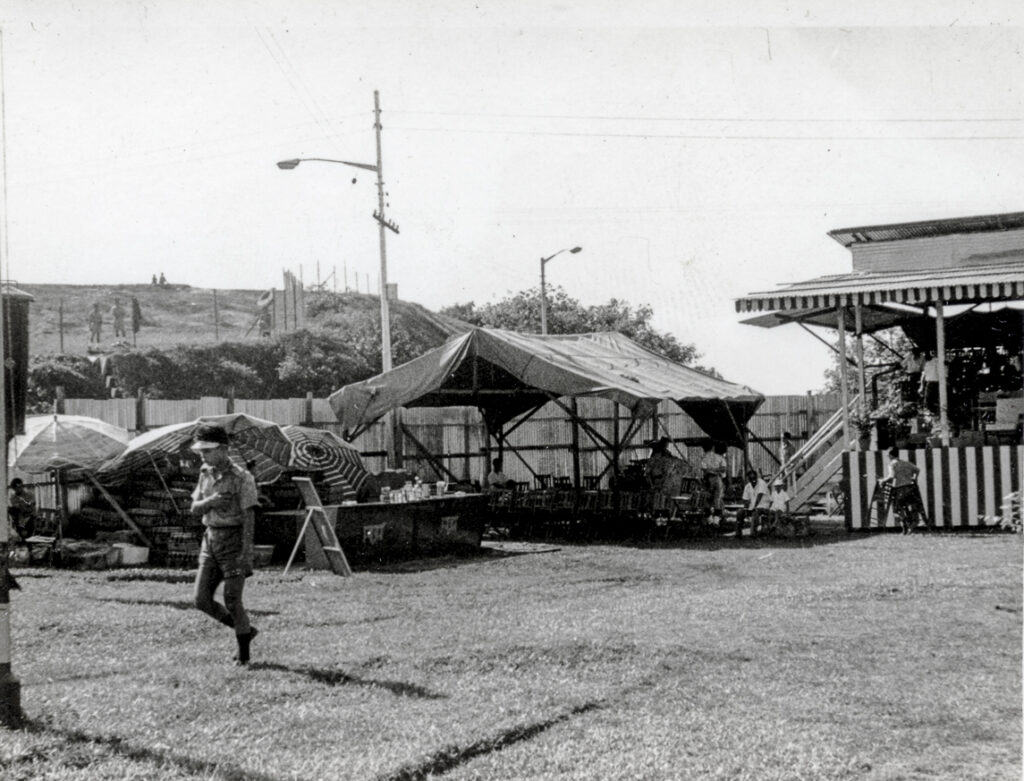
Sembawang Hill in the background. The VIP enclosure is to the left of this 1965 photo.
And that’s only what’s in the background of that one postcard photo! The cars in the photo feature in the following online articles (links below) and in various articles that were published in Rewind Magazine:
60 YEARS AGO: THE ORIENT YEAR GRAND PRIX
FOR THE PRICE OF A HOUSE – ASTON MARTIN DB3S/106
JUST THE RIGHT AMOUNT OF TORQUE
OTHER REFERENCES
Singapore Grand Prix (1961) Program
Thomson, John Turnbull. Some Glimpses into Life in Malayan Lands, a candid account of his life in Penang and Singapore, 1864. Reprinted by Oxford University Press in 1985, 1991.
Hall-Jones, John, & Hooi, Christopher. An Early Surveyor in Singapore: John Turnbull Thomsonin Singapore, 1841–1853. Singapore: National Museum. (1979)
Hall-Jones, John. The Thomson Paintings – Mid-Nineteenth Century Paintings of the Straits Settlements and Malaya. Oxford University Press (1983)
Sim, Cheryl. John Turnbull Thomson. https://eresources.nlb.gov.sg/infopedia/articles/SIP_818_2005-01-22.html
Solomon, Eli. Snakes & Devils – A History of the Singapore Grand Prix. Marshall Cavendish (2008)
Solomon, Eli. Teretonga Calling. Rewind Magazine Issue 011, July 2012.
Solomon, Eli. The Garden of Foolish Pleasures. Rewind Magazine Issue 023, July 2015.
Yong Hwee Oh, et al. The Garden of Foolish Indulgences. Pause Narratives, 2016.
TAGS: Singapore Grand Prix, Malaysia Grand Prix, Upper Thomson Road, Robert Peirce, Peirce Reservoir, John Turnbull Thomson, Serangoon District Office, Sembawang Hill Circus, Teachers’ Housing Estate, Thomson Hills Estate, Ahmad Ibrahim School, Yio Chu Kang Road, Postcard, A.S.M.K. & Co., Sembawang Baptist Church, Casuarina Road
This article is the first Rewind Media’s online Viewfinder series.
For more on the history of the Singapore Grand Prix, check out this book – Snakes & Devils – A History of the Singapore Grand Prix.
Footnotes
- The 1962 Grand Prix in Singapore was referred to as the Malaysia Grand Prix. Organiser was the Singapore Government’s Ministry of Culture and the event was held on 22 and 23 April that year. The change in name prior to the official establishment of the Federation of Malaysia (in which Singapore was a member) in 1963 was, according to S. Rajaratnam, then Singapore’s Minister of Culture, “fittingly called the Malaysia Grand Prix, as it is expressive of the new spirit of co-operation to which we the peoples of Malaysia are looking forward.”
- John Turnbull Thomson (b. 10 August 1821 – d. 16 October 1884). In 1838, the 16-year-old English lad arrived in Singapore on his way to Penang. Five years later, he returned to Singapore as the country’s Government Surveyor. For the next twelve years, he played a dual role of surveyor and Government Engineer. Singapore’s Horsburgh Lighthouse was designed by him, and Thomson Road named after him. In 1960, Singapore’s first motor sprint (see A GARDEN OF FOOLISH PLEASURES for the story behind the first Old Upper Thomson Road Sprint) was held on Old Upper Thomson Road, followed a year later by the inaugural Upper Thomson Road Grand Prix. When he left Singapore in the 1850s for New Zealand, he was offered the position of Chief Surveyor of the Province of Otago, located so far south it was closer to the South Pole than to Singapore. He accepted the challenge. Long, cold nights gave him the opportunity to collect his thoughts and he penned Some Glimpses into Life in Malayan Lands, a candid account of his life in Penang and Singapore, published in 1864 (reprinted by OUP in 1985 and 1991). After three years as Surveyor-General of New Zealand, Thomson retired to Invercargill in 1855, a town in which he is credited for laying out. Thomson was also a gifted painter, a hobby he picked up after arriving in Asia, and ninety-three of his paintings, most of his stay in Malaya, have survived, carefully preserved by his descendants in New Zealand (Hall-Jones, John. The Thomson Paintings – Mid-Nineteenth Century Paintings of the Straits Settlements and Malaya. OUP, 1983). He died in 1884 at the age of sixty-three, but his legacy lives on in road names in Singapore.
- Suburban developer Faber Union launched Thomson Hills Estate in early 1972. The terraced and semi-detached houses were occupied around the time of the last Singapore Grand Prix in April 1973 – I remember because we moved into our new home on the Sunday afternoon of the final Singapore Grand Prix).
- This housing estate was established in 1956 and developed in phases over the years.
- Peirce Reservoir was named after Municipal Engineer Robert Peirce (b. January 1863 – d. 30 March 1933) at a Municipal Commissioners meeting on 30 July 1921). Peirce arrived in Singapore in 1901 following a near 10-year stint as Municipal Engineer in Penang. He arrived as Municipal Engineer and retained that position till retirement in 1916. Peirce is credited with the construction of Anderson Road, Cairnhill Road, Cantonment Road, Chatsworth Road, Moulmein Road, Nassim Road and, Nathan Roads, though his major contribution to Singapore was related to the construction and extension of reservoirs on the island and a water-borne sewerage system. The Johore water pipeline was another of Peirce’s ideas (report made in 1904) with supply from Gunong Pulai in Johor.
- LAY OF THE LAND: Today, Upper Thomson Road is just another dual-carriageway in an area that is predominantly residential redevelopment. It begins after the MacRitchie Reservoir and continues north to the junction of Mandai Road where it joins Sembawang Road. Up to February 1939, this was simply called Thomson Road, stretching from Newton northwards. For a period after the Second World War, Upper Thomson Road was a section that commenced at the entrance to Lower Peirce Reservoir, where the Kallang River crossed Ang Mo Kio Village (the village was official named in 1938), and ended at the Mandai Road junction. This two-lane black top meandered through kampongs and plantations and was the trunk road that fed the island’s Naval Base at Sembawang in the north. It also provided an alternative route to the Causeway and thus Malaysian hinterland, via Mandai Road. In 1958, a new trunk road scythed through some of the plantations between Lower Peirce and the Seletar Rifle Range (created in early 1923 by the Forest Guard Quarters, later renamed Nee Soon Rifle Range) to improve the flow of traffic to and from the various military camps and the naval base. This new road soon attained a reputation as an ideal drag strip for speedsters. Residents along the road moaned of this new menace in letters to the forum pages of the Straits Times. All this was before the road became part of the Grand Prix circuit from 1961-1973.
- In some photos of the Grand Prix, houses at Casuarina Road can be seen in the background, including the Sembawang Baptist Church at 140 Casuarina Road (Sembawang Hills Estate, 7 1/2mile, Thomson Road). While the church had been established earlier, it was in 1957 that a corner shophouse was purchased at Casuarina Road and the church relocated there from 10-mile Nee Soon Road. The new church officially operated from Casuarina Road from January 1958 as the Baptist Gospel Centre.

